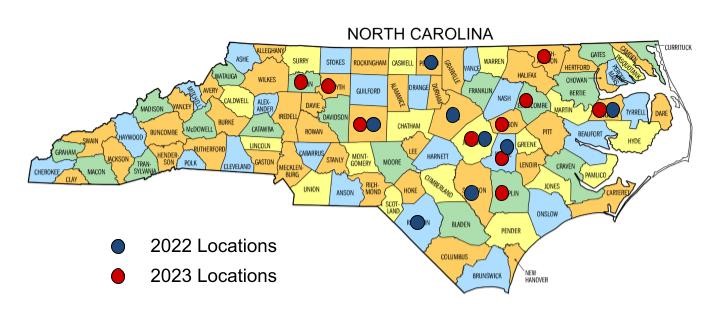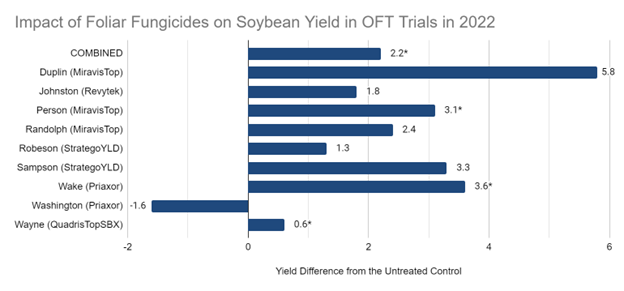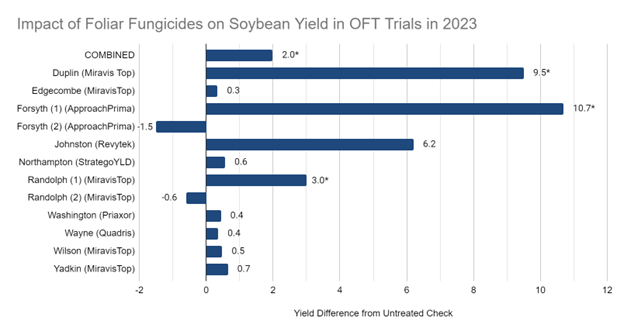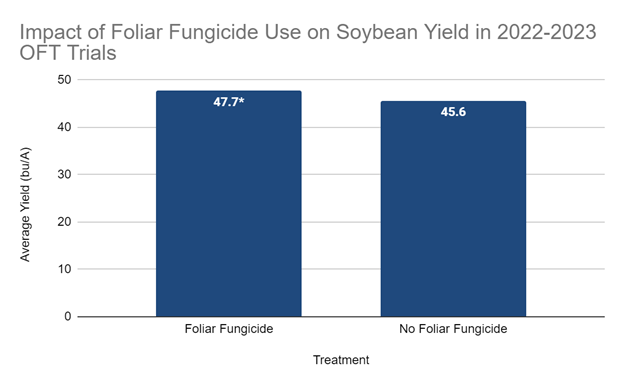Soybean On-Farm Trial Results: Foliar Fungicide Use
go.ncsu.edu/readext?987106
en Español / em Português
El inglés es el idioma de control de esta página. En la medida en que haya algún conflicto entre la traducción al inglés y la traducción, el inglés prevalece.
Al hacer clic en el enlace de traducción se activa un servicio de traducción gratuito para convertir la página al español. Al igual que con cualquier traducción por Internet, la conversión no es sensible al contexto y puede que no traduzca el texto en su significado original. NC State Extension no garantiza la exactitud del texto traducido. Por favor, tenga en cuenta que algunas aplicaciones y/o servicios pueden no funcionar como se espera cuando se traducen.
Português
Inglês é o idioma de controle desta página. Na medida que haja algum conflito entre o texto original em Inglês e a tradução, o Inglês prevalece.
Ao clicar no link de tradução, um serviço gratuito de tradução será ativado para converter a página para o Português. Como em qualquer tradução pela internet, a conversão não é sensivel ao contexto e pode não ocorrer a tradução para o significado orginal. O serviço de Extensão da Carolina do Norte (NC State Extension) não garante a exatidão do texto traduzido. Por favor, observe que algumas funções ou serviços podem não funcionar como esperado após a tradução.
English
English is the controlling language of this page. To the extent there is any conflict between the English text and the translation, English controls.
Clicking on the translation link activates a free translation service to convert the page to Spanish. As with any Internet translation, the conversion is not context-sensitive and may not translate the text to its original meaning. NC State Extension does not guarantee the accuracy of the translated text. Please note that some applications and/or services may not function as expected when translated.
Collapse ▲What is the Soybean On-Farm Trial Program? The North Carolina Soybean On-Farm Trial (OFT) Program was initiated in 2020 as a collaborative effort between N.C. Cooperative Extension and the NC Soybean Producers Association. This program leverages the talent and resources that N.C. Cooperative Extension has at the local level to conduct on-farm research in strip trials that synergizes research being conducted in small plots by NC State University. Jeff Chandler with the NC Soybean Producers Association now manages the program in collaboration with NC State. You can view previous protocols and results.
The North Carolina Soybean OFT investigated the value of foliar fungicides applied around R3 in NC soybeans in 2022 and 2023 at 21 locations across the state (Figure 1). Extension Agents across North Carolina worked with growers in their area to host replicated strip trials of treated and untreated strips (you can see an example of a map in the protocol). Farmers and Agents worked together to pick the foliar fungicide product that was most applicable to the farmer operation, so a variety of foliar fungicide products are represented in the data. Farmer equipment was used to plant, spray, and harvest the trials. Each site was planted with seed provided by the OFT Program that was moderately susceptible to frogeye leaf spot.

Figure 1. Soybean On-Farm Trial locations across North Carolina evaluating foliar fungicide use in 2022 and 2023
2022 Results: Foliar fungicides significantly increased yield at 3 individual locations in 2022 (Figure 2). When locations were combined, there was a statistically significant yield protection of 2.2 bu/A from the use of foliar fungicides across these locations (Figure 2)
2023 Results: Again in 2023, foliar fungicides significantly increased yield at 3 individual locations (Figure 3). When locations were combined, there was a statistically significant yield protection of 2.0 bu/A from the use of foliar fungicides across these locations (Figure 3).
Combined Results: When combining all locations and years (21 total locations), the treated plots had a statistically significant yield protection of 2.1 bu/A (Figure 4). No statistical differences were observed between different fungicide types evaluated and their impact on soybean yield.
Overall, these results indicate that on average the use of foliar fungicides protect soybean yield by 2 bu/A. The environmental impacts (i.e. weather) and disease presence can impact the level of yield protection seen, but generally there is a positive yield impact when foliar fungicides are used. The data to support this claim came from 14 different counties over two years, providing a strong representation of North Carolina, and compliment both small-plot and producer-derived data from the NC State Soybean Extension Program indicating that foliar fungicides consistently impact soybean yield in the state when diseases are present and susceptible to moderately susceptible varieties to frog eye leaf spot are used.
If you would like to be a part of the Soybean OFT program in the future, please contact your local extension agent to learn more about the upcoming research in the North Carolina On-Farm Trials Program!





